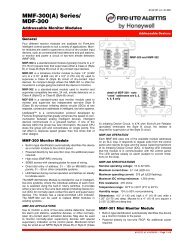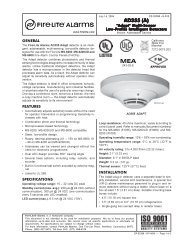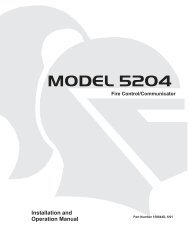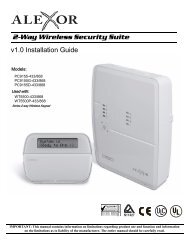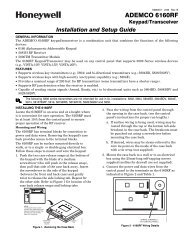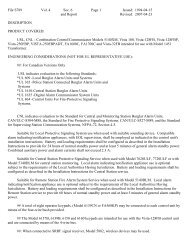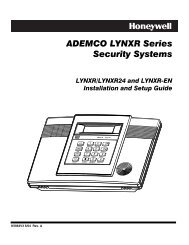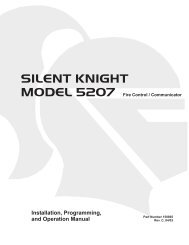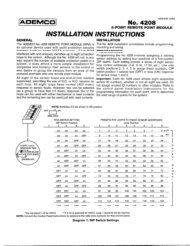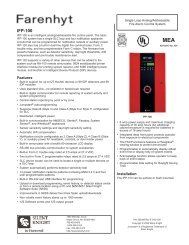Internet Communications Module 7845i - Patriot Alarm Systems, Inc.
Internet Communications Module 7845i - Patriot Alarm Systems, Inc.
Internet Communications Module 7845i - Patriot Alarm Systems, Inc.
You also want an ePaper? Increase the reach of your titles
YUMPU automatically turns print PDFs into web optimized ePapers that Google loves.
<strong>Internet</strong> <strong>Communications</strong> <strong>Module</strong> <strong>7845i</strong> Installation and Setup Guide<br />
3-2<br />
Logically, downstream video programming signals begin around 50 MHz, the equivalent of<br />
channel 2 for over-the-air television signals. The 5 MHz - 42 MHz portion of the spectrum is<br />
usually reserved for upstream communications from subscribers' homes.<br />
Each standard television channel occupies 6 MHz of RF spectrum. Thus a traditional cable<br />
system with 400 MHz of downstream bandwidth can carry the equivalent of 60 analog TV<br />
channels and a modern HFC system with 700 MHz of downstream bandwidth has the<br />
capacity for some 110 channels.<br />
To deliver data services over a cable network, one television channel (in the 50 - 750 MHz<br />
range) is typically allocated for downstream traffic to homes and another channel (in the 5 -<br />
42 MHz band) is used to carry upstream signals.<br />
A headend cable modem termination system (CMTS) communicates through these channels<br />
with cable modems located in subscriber homes to create a virtual local area network (LAN)<br />
connection. Most cable modems are external devices that connect to a personal computer<br />
(PC) through a standard 10Base-T Ethernet card or Universal Serial Bus (USB) connection,<br />
although internal PCI modem cards are also available.<br />
The cable modem access network operates at Layer 1 (physical) and Layer 2 (media access<br />
control/logical link control) of the Open System Interconnect (OSI) Reference Model. Thus,<br />
Layer 3 (network) protocols, such as IP traffic, can be seamlessly delivered over the cable<br />
modem platform to end users.<br />
A single downstream 6 MHz television channel may support up to 27 Mbps of downstream<br />
data throughput from the cable headend using 64 QAM (quadrature amplitude modulation)<br />
transmission technology. Speeds can be boosted to 36 Mbps using 256 QAM. Upstream<br />
channels may deliver 500 kbps to 10 Mbps from homes using 16QAM or QPSK (quadrature<br />
phase shift key) modulation techniques, depending on the amount of spectrum allocated for<br />
service. This upstream and downstream bandwidth is shared by the active data subscribers<br />
connected to a given cable network segment, typically 500 to 2,000 homes on a modern HFC<br />
network.<br />
An individual cable modem subscriber may experience access speeds from 500 kbps to 1.5<br />
Mbps or more (depending on the network architecture and traffic load); blazing performance<br />
compared to dial-up alternatives. However, when surfing the Web, performance can be<br />
affected by <strong>Internet</strong> backbone congestion.<br />
In addition to speed, cable modems offer another key benefit: constant connectivity. Because<br />
cable modems use connectionless technology, much like in an office LAN, a subscriber's PC is<br />
always online with the network. That means there's no need to dial-in to begin a session, so<br />
users do not have to worry about receiving busy signals. Additionally, going online does not<br />
tie up their telephone line, which is very important in an emergency reporting situation.<br />
ADSL (Asynchronous Digital Subscriber Line) Primer<br />
Asymmetric Digital Subscriber Line (ADSL) is a competing modem technology that converts<br />
existing twisted-pair telephone lines into access paths for multimedia and high-speed data<br />
communications. ADSL can transmit up to 6 Mbps to a subscriber, and as much as 832 kbps<br />
or more in both directions.<br />
An ADSL circuit connects an ADSL modem on each end of a twisted-pair telephone line,<br />
creating three information channels -- a high-speed downstream channel, a medium speed<br />
duplex channel, depending on the implementation of the ADSL architecture, and a POTS<br />
(Plain Old Telephone Service) or an ISDN channel. The POTS/ISDN channel is split off from<br />
the digital modem by filters, thus guaranteeing uninterrupted POTS/ISDN, even if ADSL<br />
fails. The high-speed channel ranges from 1.5 to 6.1 Mbps, while duplex rates range from 16<br />
Technical Manuals Online! - http://www.tech-man.com



